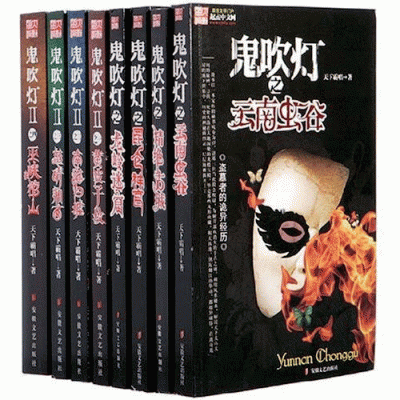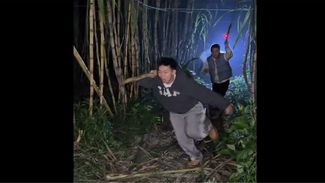The secret language of China’s grave robbers
“In modern times, simply finding the location of an ancient tomb is more difficult than the process of getting it open. All those spots marked by an obvious pile of earth, a stone stele or some such, have already been dug up. If you want to find those tombs that have lain hidden for centuries beneath the earth with no above-ground marking to signify their presence, then you’re going to need certain technical knowledge and apparatus, like gavelocks, Luoyang shovels, bamboo nails, drills and the like. Some specialists don’t rely on such tools, and instead search within ancient tomes for clues that will lead them to lost tombs. Even fewer still have a knowledge of the occult sciences, and use the techniques of geomancy to read the lie of the land in their search for the resting places of the dead. I myself belong to the latter category…”
Zhang Muye, “Ghost Blows Out the Light” (《鬼吹灯》)

'Ghost Blows Out the Light'
As a discipline, archaeology is mostly about taking soil samples. At its most exciting, it involves poking about in a wet ditch looking for bits of broken pottery. But don’t despair just yet, for there’s a black sheep in the extended archaeological family: grave robbery. Conducted under the cover of darkness, grave robbery is a dirty (both spiritually and physically) and highly illegal profession. Yet it has become wildly popular in China, thanks to a couple of pulp serials: “Grave Robbers’ Chronicals” (《盗墓笔记》Dàomù bǐjì) and “Ghost Blows Out the Light” (《鬼吹灯》Guǐ chuīdēng). Published over the last decade, these adventure-horror series have quickly become known as the Indiana Jones stories of China—only with fewer fedoras and bullwhips, and more Mao caps and feng shui compasses. The link with archaeology remains, however: Chinese grave robbers like to refer to themselves in polite company as “hobbyist archaeologists,” or kaoguxue aihaozhe (考古学爱好者).
The Chestertonian paradox that thieves have a great respect for private property (they merely wish it to become their property “that they may more perfectly respect it”) has never been more true than for grave robbers. These are people who pride themselves on liberating long-forgotten treasures, be it for public good or personal gain. Grave robbers also learn to respect the inhabitants of the tombs, and the treasures that they contain, for not to do so can lead to…unpleasantness. It’s said that grave robbers from a certain tradition have a custom of lighting a candle in the southeast corner of a tomb upon entering. If the candle is extinguished, it means that the spirits within do not welcome the intrusion, and the grave robbers are obliged to leave empty-handed—hence the title of the book: “Ghost Blows Out the Light.”
Grave Robbers’ Parlance
Be warned, for this is not the Chinese that your everyday salary-man or pen-pusher will be familiar with. That said, if you enjoy scouring backstreet antique markets for obscure treasures, you’re more than likely to come across a stall or two operated by grimy-fingered grave robbers…
Chinese authorities estimate that as many as 100,000 grave robbers could be roaming the country, searching for ancient tombs to pilfer. Naturally, an illicit subculture of this size has its own argot, not unlike medieval thieves’ cant. Though the following sentences and vocabulary have been adapted from the aforementioned novels, a hobby archaeologist friend of mine confirms that the language is used in the actual communities.
As with all sexy black market terminology, the grave robbers’ parlance was essentially designed to obfuscate potentially incriminating details: valuable scrolls of calligraphy or paintings are nonchalantly referred to as “paper” (纸儿 Zhǐr), while precious jade artefacts are simply “stones” (石头 Shítou). Grave robbers themselves call their profession daodou (倒斗), or “emptying the ladle,” because a tomb resembles the shape of an inverted ladle.
The novels are supposedly written by ex-grave robbers, and the narrative conceit is that they are true tales (or at most lightly embellished stories) of their exploits. It’s important to separate fact from fiction, as Chinese grave robbing is a very real problem, and China’s Ministry of Public Security estimates that some 200 million ancient Chinese graves were illicitly excavated in recent years alone.
In the books, if not in real life, there are plenty of supernatural goings-on. In ancient China, people believed that death was merely the end of the physical body, and that the spirit lived on. Grave robbers have stories of the inhabitants of the tombs—the corpses—springing to life and chasing after intruders, driven by a blind hunger for the very breath of the living, the invaluable life force known as yangqi (阳气). Naturally, there are words to classify different kinds of corpses in varying stages of decay. Fleshy, well-preserved corpses are named after the sticky triangular rice cakes known as zongzi (粽子), probably because naming corpses after a tasty snack of gloopy rice, itself embalmed in leaves of bamboo, is quite a delicious irony.

Decayed corpses that are little more than piles of bone are ganzongzi (干粽子) or “dry zongzi,” while rouzongzi (肉粽子), “meaty zongzi,” refers to corpses that are adorned with valuables. What all grave robbers wish to avoid are the dazongzi (大粽子), the “big zongzi,” which are the re-animated corpses out for blood, breath and brains.
We have an ancient tomb here, and legend has it that the undead reside within.
Wǒmen zhè li yǒu gè gǔ mù, tīng shuō lǐbian yǒu dà zòngzi.
我们这里有个古墓,听说里边有大粽子。
When two grave robbers get together to discuss their profession, an outsider listening in is likely to be left scratching their head in confusion. Take for example the following simple exchange:
May I ask this most skilled of associates, whereabouts do you search for tombs, and what kind of tomb are you most adept at entering?
Gǎn wèn zhè wèi dǐng shàng yuán liáng, zài héfāng fēnguò shān jiǎ, chāi jiě de jǐ dào qiū mén?
敢问这位顶上元良,在何方分过山甲,拆解得几道丘门?
Here yuanliang (元良), literally “great virtue,” is an honorific term used by grave robbers to denote someone of the same profession. Fen shanjia (分山甲), literally “part the shell of the mountains,” means “to prospect for tombs to rob,” and chaijie qiumen (拆解丘门) means “to break into a tomb and disassemble its traps” (丘门 literally means “grave door”).
My skills are nothing really; what I know has merely been passed down from generation to generation in my family. I roam far and wide, and work on tombs from all eras.
Wú yǒu yuán liáng, shānshàng bān cháishān xià shāohuǒ, zhè gū fēn shān jiǎ, yàozi jiě qiū mén.
无有元良,山上搬柴山下烧火,鹧鸪分山甲,鹞子解丘门。
In reply, the speaker first modestly deflects the compliment, then utters the phrase “collect firewood on the mountain and make a fire at its foot” (山上搬柴山下烧火), to indicate that he learned his grave-robbing skills from his ancestors. Zhegu (鹧鸪, partridge) stands for “all around” in grave robber’s parlance, and yaozi (鹞子, sparrow), means “in all ages.”
Tools and Traps
Information that may be of use during those unfortunate moments in life when one finds oneself trapped 10 feet underground in the antechamber of a labyrinthine Han Dynasty (206 B.C. – 220 A.D.) mausoleum…
Luoyang shovel 洛阳铲 Luòyáng chǎn.
Invented in 1923 by a grave robber from Luoyang, the shovel is the one article of archaeological equipment that no self-respecting grave robber should be without. A U-shaped cylinder some two inches in diameter, the Luoyang shovel allows the user to extract a long section of earth while preserving the soil structure. Thus the grave robber can analyze the soil for any evidence of underground structures.
Where there are grave robbers, there are countermeasures, which most commonly take the form of traps designed to catch intruders unawares. A few of the most common are:
Crossbow trap 暗努弩 Ànnǔ
The bread and butter of tomb-based anti-theft devices, the crossbow trap is triggered by tripping a cord or stepping on a mechanism that shoots a crossbow bolt from a hidden alcove. Legend has it that the tomb of the First Emperor, Qin Shi Huang, is rife with crossbow traps.
Sand trap 流沙 Liúshā`
In fiction, the sand trap involves a complex mechanism that, when triggered, drops a heap of sand on the unsuspecting intruder from above, thus burying them alive. In reality, tombs have been discovered in which the entire burial chamber is filled with fine sand. This protects it from being violated, as any prospective grave robber would simply find sand pouring out of any entrance hole they happen to unearth.
Revolving floor panel 连环翻板 Liánhuán fānbǎn
A favorite device in grave-robbing fiction, the revolving floor panel is a wooden floor board that covers a pit some three meters deep. The board is designed to give way when pressure is applied, before returning to its original position. The unfortunate trespasser is cast into the pit below, where sharp spears or wooden stakes await…

Grave Robbers’ Mantra
The techniques of grave robbing can be summed up with the four-character mantra: 望闻问切 (wàng wén wèn qiè), “look, smell, ask and feel.” The same four-character formula (with understandably different explanations) is used in Chinese medicine as a method of diagnosis.

Look (望 Wàng) means practicing feng shui, or examining the layout of the landscape (according to things like geographical features and cardinal directions) to locate the most auspicious spot where a tomb is likely to be located. Experts in this art can find the locations of hunt down tombs simply by taking a close look at the terrain.
 Smell (闻 Wén) is the art of using one’s nose to smell the surface soil above a tomb to determine its age and whether or not the grave has already been robbed. It is said that the most skilled in this art can detect slight differences in odor between the earth excavated from tombs of the Han and Tang dynasties.
Smell (闻 Wén) is the art of using one’s nose to smell the surface soil above a tomb to determine its age and whether or not the grave has already been robbed. It is said that the most skilled in this art can detect slight differences in odor between the earth excavated from tombs of the Han and Tang dynasties.
Ask (问 Wèn) is the method of casing an area by talking to the locals, especially the elderly, and finding out information about the location of nearby tombs, and the wealth of those buried therein. Grave robbers skilled in this technique normally dress like a wandering feng shui master, and are blessed with the gift of the gab.
Feel (切 Qiè) is the art of finding the quickest and most direct route from the surface to the coffin chamber. It also entails finding the most valuable items in the tomb by opening the coffin and examining the corpse, including its various bodily orifices (corpses of female nobility often contained precious jade in the mouth cavity).
Like the article? You can buy the rest of the Adventure Issue in our store.











